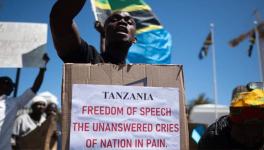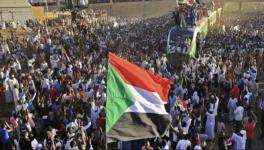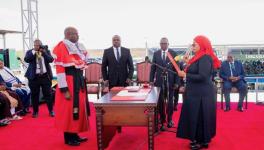Lest We Forget: The Shocking Crimes of Imperialism

Representational image. | Image Courtesy: US National Archives
The people of Afghanistan appear to be falling from one catastrophe into another. After the foreign occupation and civil strife ended, a fanatic Taliban, which betrays every sign of lacking basic political understanding and will to bring diverse ethnic and religious groups together, rules the country. The tragedy of one of the poorest and least developed countries offers a window to political contradictions of the current world order.
The implosion of the erstwhile Afghan state, which was propped up for two decades by western liberal capitalist countries, illustrates the limits of contemporary imperialism. This imperialism cloaks its violence under a humanitarian garb but is as militaristic and racist as ever. The socio-political churning in Afghanistan show that the emancipatory potential of nation-states for the people of the third world is perhaps over. As elites in the third world align their interests with the imperialist metropole, the nation as an imagined political community that empowers masses appears more of a chimaera than a possibility.
Ground Realities of US Occupation
Media narratives on the current state of Afghanistan began with the United States-led invasion in 2001 after the 9/11 attacks in New York. This is a deliberately selective reading of the recent history of the country. Western imperial powers have been militarily invested in it at least since 1979. As John Pilger notes in a recent article, the Jimmy Carter administration had authorised a $500 million covert CIA operation code-named Operation Cyclone on 3 July 1979 to overthrow the then Afghan government led by the People’s Democratic Party of Afghanistan (PDPA). It was six months before the Soviet invasion of Afghanistan on 24 December 1979. The plan was to arm Islamic jihadists against the secular and left-oriented Afghan government, with deep operational support from the Zia-ul-Haque regime in Pakistan and ideological and financial support from the Saudi monarchy. Pilger quotes a communique of August 1979 from the American embassy in Kabul: “...the United States’ larger interests...would be served by the demise of the PDPA government, despite whatever setbacks this might mean for future social and economic reforms in Afghanistan.”
Contrary to the imperialist readings of Afghanistan, which see its history purely in terms of ‘Great Power’ games, the Saur Revolution of April 1978 was rooted in the internal political crises of that period. The revolution was motivated by an anti-feudal, secular and social welfare programme, including land reform, public provision of education and health, and prohibition of religion-based traditional oppression of women. The PDPA shared this ideology with several governments in the late 1970s in countries like Nicaragua, Angola, Mozambique, or Ethiopia, where left-leaning revolutionaries had gained power after armed struggles. The erstwhile privileged strata in all these countries opposed the revolutionaries’ programme of socio-economic change. The situation worsened because of imperial interventions.
In all cases, Western imperialism armed and aligned with the most reactionary, violent and racist elements: The Contras in Nicaragua, the apartheid regime of South Africa and Islamic fundamentalists in Afghanistan. So much for the democratic and liberal pretensions of Western liberal regimes. The popular discourse in Western countries justifies such choices through the prism of the Cold War. But that precisely is the core of imperialist ideology, which looks at the dominated parts of the world purely through the imperial centre’s military, political and economic calculus. As if dominated societies have no internal histories and politics.
The PDPA government enjoyed limited influence in rural Afghanistan. Its base mainly consisted of urban professional strata. The revolution stood little chance against the combined strength of internal opposition and externally funded and armed mujahideen. Factional struggles within the PDPA worsened the situation. Fearful of a right-wing Islamist regime below its soft underbelly in Central Asia, the USSR launched a swift armed occupation, further alienating masses from the PDPA regime. However, the PDPA government survived for three years after Soviet withdrawal in 1989 and even the dissolution of the USSR. It provides instructive clues to differences between the social character of its state power and the Afghan government established after the US occupation.
The PDPA government refused to throw in the towel, and its functionaries fought till the end because its political base felt a deep stake in the future of Afghanistan. On the other hand, the US-sponsored Afghan government fell like a house of cards once the over-lordship of the US armed forces was withdrawn. Its functionaries saw little stake in Afghanistan and thought it better to flee and get themselves evacuated by the United States than stand to defend any values espoused by the regime.
Ever since the US-NATO Afghan invasion ended, as a measure of stock-taking by invaders, the trillion dollars the United States spent on war and reconstruction in Afghanistan is being bandied about. The audit report of the Special Inspector General for Afghanistan Reconstruction presents detailed figures. The United States Department of Defense spent $816 billion on its operations in Afghanistan. Compared to this amount, actually recycled on troops and armaments of the American war machine, the money spent on so-called reconstruction was only $130 billion. Even of this money spent ‘in’ Afghanistan, $83 billion went to Afghan defence forces. Also, a good proportion of it would have flown back to the United States for weapons purchases, training expenses, contractor fees, etc. According to Jeffrey Sachs, a development economist at Columbia University, only $21 billion could be counted as “economic support” to Afghanistan, a mere 0.2% of nearly one trillion dollars spent on making war on the country (quotes in the original by Sachs). This economic support comes to about $30 per Afghan per year. If the US rulers thought they could buy Afghans’ sense of freedom by this pittance, they surely were living in a fool’s paradise.
In political-economic terms, the post-2001 Afghan state was a neo-liberal client state without sovereignty or even will to sovereignty. American and NATO troops did as they pleased, arresting and killing anyone they wished. Social service programmes got outsourced to local branches of first-world NGOs, their ex-pat experts receiving first world salaries in one of the poorest countries. Even the 3,00,000-strong Afghan National Defense and Security Forces (ANDSF), on which $83 billion was spent, was created, armed and trained to be ground troopers for the US-NATO air war. The purpose was to minimise US-NATO losses from ground fire. While the US-NATO forces would fire missiles, including drone missiles, from the safety of their aeroplanes and bases, Afghan national forces faced the brunt of armed insurgency on the ground.
The contrast between the casualties suffered by the US-NATO and Afghan forces is staggering. According to figures collected up to December 2019 by the Costs of War project of Brown University, about 2,300 American soldiers lost lives in the Afghan war. The number of Afghan defence and police forces who lost life by then was twenty-eight times higher at 64,000, which would increase if casualties of the last months of the war were included.
The US-NATO forces did not treat the Afghan state and its defence forces as more than hirelings. The Afghan government was completely sidelined at the Doha negotiations with the Taliban, their sole aim being a safe American withdrawal. Most shameful was the American withdrawal from their largest military base at Bagram in the middle of the night on 2 July 2021 without even informing the Afghans. It, of course, was only a reflection of the Afghan-US relationship. Americans were the boss; neither did the Afghans think of themselves as hosts, nor had the Americans ever the decency to behave as guests.
Crisis of Imagination of Democracy
Even more ironic is the claim of the Western powers that they tried to build a democratic Afghanistan. The irony is that even rivals to US hegemony, Russia and China, accept this claim. During a press conference, Russian President Vladimir Putin assessed the US-NATO adventure by saying, “It is time to drop the irresponsible policy of imposing alien values, of imposing a democracy under alien standards, not reckoning with either historical, or ethnic, or religious specifics.” In other words, the model of democracy is alright; it is the imposition of democracy that is wrong.
Putin, of course, is no savant of democracy and is using the US-NATO debacle in Afghanistan to counter the ideological offensive of Western liberal countries against Russia and China. As majoritarian and authoritarian political forces gain acceptance in many countries, progressives need to be less opportunistic and more critical and careful.
The Afghan example shows the extent to which the discourse on human freedom, civil rights and democracy is depoliticised within the liberal narrative. We know the Taliban regime will not grant Afghans freedom and democracy. We also need a critical appraisal of the type of freedom and democracy Afghans enjoyed under American occupation. Harping on the first while shying away from the second is the hallmark of liberal disposition. Two conceptual misrecognitions underpin liberal understanding of society. First is the misrecognition of the social foundations of freedom and democracy and their reduction to a disembodied framework of individual rights. Second is the fetishisation of this framework so that even clearly evident aspects of the social life of a people are not seen.
For example, only a minute fraction of relatively well-off urban Afghans aligned with the occupying forces were in a position to enjoy the kinds of freedoms that the Taliban regime will take away. Such liberties are undoubtedly important to these people, and they would rather live elsewhere than under the Taliban. However, their legitimate anxieties about their future tell us little about the predicaments of the 95% rural and urban poor Afghans. Any freedom gets circumscribed by the character of the political power guaranteeing that freedom. The very fact that a foreign force occupied their country meant the Afghan people were not free.
Conceptual misrecognitions of liberalism are not ‘errors’ in the domain of ideas. To the extent liberalism is hegemonic, it is the operational ideology of the economically and politically powerful. Reducing freedom and democracy to private rights and fetishising them actually weakens the recognition of social, economic, and political inequalities. The liberal narrative on freedom and democracy is the justificatory discourse of current imperialism, which is accepted as a ‘white man’s burden’ in the mass ideology of imperialist countries. International human rights NGOs and even social elites in many dominated countries cater to this liberal notion of freedom and democracy.
People can enjoy freedom and democracy only within a community of equal citizens. Both are in critical condition in countries at the peripheries of the capitalist world order. The crucial causative factors are the neo-liberal turn of all capitalist states and international migrations of labour and professional strata in the era of globalised capital. Anti-colonial struggles in many of these countries had created, or at least planted seeds of, a political community that imagined itself as a nation.
The post-independence neo-liberal turn of nation-states to privatisation, devaluation of social welfare and submitting their economic sovereignty to institutions of global capital have fractured this community. The majority of the economically vulnerable have been pushed to the daily grind of life of precarity. Simultaneously, the globalisation of capital, culture and professional strata, a process centred around metropolitan countries, has meant that socially influential sections of these nations can simply pack their bags and secede. Recourse to majoritarian violence, and efforts to regroup the nation around its vicarious pleasures, is a response of the politically powerful to this crisis of nations. The Taliban is one variant of this response. Other responses are visible, at different stages of success, in most third-world countries, including India.
The arc of resistance and revolution of the late nineteen seventies, from Asia, Africa to Latin America, including the Saur revolution of Afghanistan, has become the last progressive flare of nation-based armed progressive movements in the third world. Imperialist interventions everywhere have managed to weaken and destroy these movements. In their wake, as in Afghanistan, these interventions have left graveyards of freedom and equality. While the progressives in these countries have an urgent struggle at hand, two things should be clear. A class-based model of democracy that engages directly with ordinary people’s struggles rather than the aspirations of social elites is a prime necessity. Second, liberal pretensions cannot wash away the crimes of imperialism.
The author teaches Physics at St Stephen’s College, University of Delhi. The views are personal.
Get the latest reports & analysis with people's perspective on Protests, movements & deep analytical videos, discussions of the current affairs in your Telegram app. Subscribe to NewsClick's Telegram channel & get Real-Time updates on stories, as they get published on our website.
























